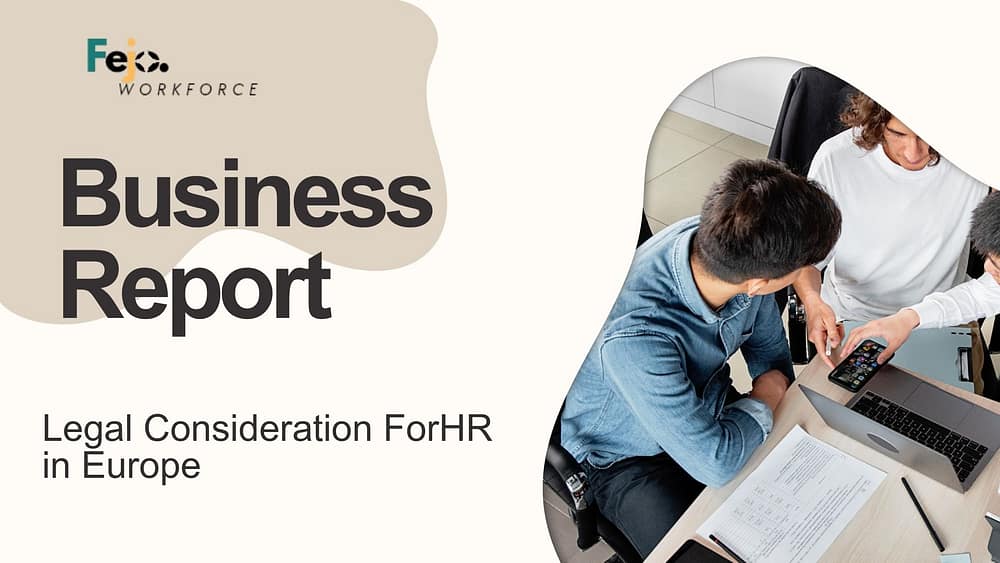Legal Considerations for HR: Staying Compliant
An overview of key legal issues HR professionals need to be aware of. Staying compliant with employment laws and regulations is a critical responsibility for HR professionals.

In today’s rapidly evolving business landscape, the role of Human Resources (HR) has become increasingly complex, especially when it comes to navigating the intricate web of legal requirements across Europe. For HR professionals, staying compliant is not just about adhering to local laws but also understanding and implementing a wide array of European Union (EU) regulations. Here’s a guide to some of the key legal considerations for HR in Europe.
1. Understanding GDPR Compliance
One of the most significant legal frameworks affecting HR departments in Europe is the General Data Protection Regulation (GDPR). Implemented in May 2018, GDPR is designed to protect the personal data of individuals within the EU. For HR, this means ensuring that all employee data is collected, stored, and processed in a way that is transparent and secure. HR professionals must ensure that employees are informed about what data is being collected and have consented to its use. Regular audits and updates to data protection policies are crucial to remain compliant.
2. Navigating Employment Law
Employment law in Europe varies significantly from one country to another, encompassing aspects such as employment contracts, working hours, minimum wage, and termination procedures. HR must be well-versed in local employment laws as well as EU-wide directives, such as the Working Time Directive and the Posted Workers Directive. It’s essential to regularly review employment contracts and policies to ensure they align with current legislation.
3. Managing Diversity and Inclusion
EU legislation strongly supports diversity and inclusion in the workplace, prohibiting discrimination on the grounds of gender, age, race, religion, and sexual orientation. HR must ensure that recruitment processes, workplace policies, and company cultures promote equality and diversity. This not only helps in staying compliant but also enhances the company’s reputation and employee satisfaction.
4. Addressing Health and Safety Regulations
Workplace health and safety is another critical area of compliance for HR. The EU has various directives aimed at ensuring high standards of health and safety at work. HR departments need to implement effective health and safety policies, conduct regular risk assessments, and provide adequate training to employees. Staying proactive in this area can prevent accidents and legal issues.
5. Implementing Fair Wage Practices
Ensuring compliance with wage practices is essential, as the EU continually works towards harmonizing pay structures across member states. HR must ensure that employees are paid fairly and in accordance with both local and EU regulations. This includes understanding the implications of recent developments like the EU Directive on Adequate Minimum Wages.
6. Staying Informed on Legal Updates
The legal landscape in Europe is dynamic, with frequent updates and new regulations being introduced. HR professionals need to stay informed about these changes to maintain compliance. This can be achieved through regular training, subscribing to legal updates, and consulting with legal experts when necessary.
Conclusion
Staying compliant with legal requirements in Europe is a challenging yet essential aspect of HR management. By understanding and adhering to GDPR, employment law, diversity and inclusion mandates, health and safety regulations, and fair wage practices, HR professionals can ensure that their organizations not only comply with the law but also foster a positive and productive work environment. Regularly updating knowledge and practices is key to navigating the complexities of European HR compliance successfully.
Boosting Morale and Performance Through Employee Recognition and Rewards
The portrayal of barbarian hordes is heavily influenced by the biases of classical historians, who frequently described these groups as uncivilized outsiders endangering the stability of established empires. However, recent research is challenging these entrenched views, highlighting the agency and resilience of these marginalized societies.

Boosting Morale and Performance Through Employee Recognition and Rewards
In today’s competitive business landscape, fostering a positive work environment is more critical than ever. A key component in achieving this is through effective employee recognition and rewards. By acknowledging and appreciating the hard work and achievements of team members, organizations can significantly enhance morale and drive performance. Let’s explore how employee recognition and rewards can transform your workplace.
The Importance of Employee Recognition
Employee recognition is not just a feel-good initiative; it is a strategic tool that can boost motivation, productivity, and engagement. Recognizing employees for their contributions helps them feel valued and appreciated, leading to higher job satisfaction and loyalty. According to a Gallup poll, employees who feel recognized are more likely to be engaged in their work, which directly impacts the overall productivity and success of the organization.
Types of Employee Recognition
- Peer-to-Peer Recognition: Encouraging colleagues to recognize each other’s efforts fosters a supportive and collaborative work culture. Implementing platforms where peers can give shout-outs or share positive feedback can enhance team dynamics and morale.
- Manager-Led Recognition: Leaders play a crucial role in setting the tone for recognition. Regular acknowledgments from managers can reinforce desired behaviors and motivate employees to continue delivering high-quality work.
- Public Recognition: Celebrating achievements in team meetings, newsletters, or on company-wide platforms can boost an individual’s confidence and inspire others to strive for similar accomplishments.
Effective Employee Reward Systems
While recognition is vital, pairing it with meaningful rewards can amplify its impact. However, it’s important to tailor rewards to suit the preferences and needs of employees. Here are some effective reward strategies:
- Monetary Rewards: Bonuses, raises, and gift cards are traditional ways to reward employees. These financial incentives can significantly boost morale, especially when tied to specific achievements or milestones.
- Non-Monetary Rewards: Flexible working hours, additional vacation days, or opportunities for professional development can be equally effective. These rewards often address employees’ work-life balance and career growth aspirations.
- Experiential Rewards: Offering experiences such as team-building activities, wellness programs, or travel vouchers can create lasting memories and strengthen team bonds.
Implementing a Successful Recognition and Reward Program
To ensure the success of your recognition and reward program, consider the following steps:
- Understand Your Workforce: Conduct surveys or feedback sessions to understand what types of recognition and rewards resonate most with your employees.
- Set Clear Criteria: Establish transparent criteria for recognition and rewards to ensure fairness and consistency across the organization.
- Communicate and Celebrate: Clearly communicate the program’s objectives and celebrate successes openly to maintain enthusiasm and participation.
- Review and Adapt: Regularly assess the effectiveness of your recognition and reward initiatives and be open to making adjustments based on employee feedback.
By implementing a thoughtful and strategic approach to employee recognition and rewards, organizations can cultivate a motivated workforce that is committed to achieving shared goals. In turn, this investment in employee satisfaction and engagement will drive performance and contribute to long-term business success.


